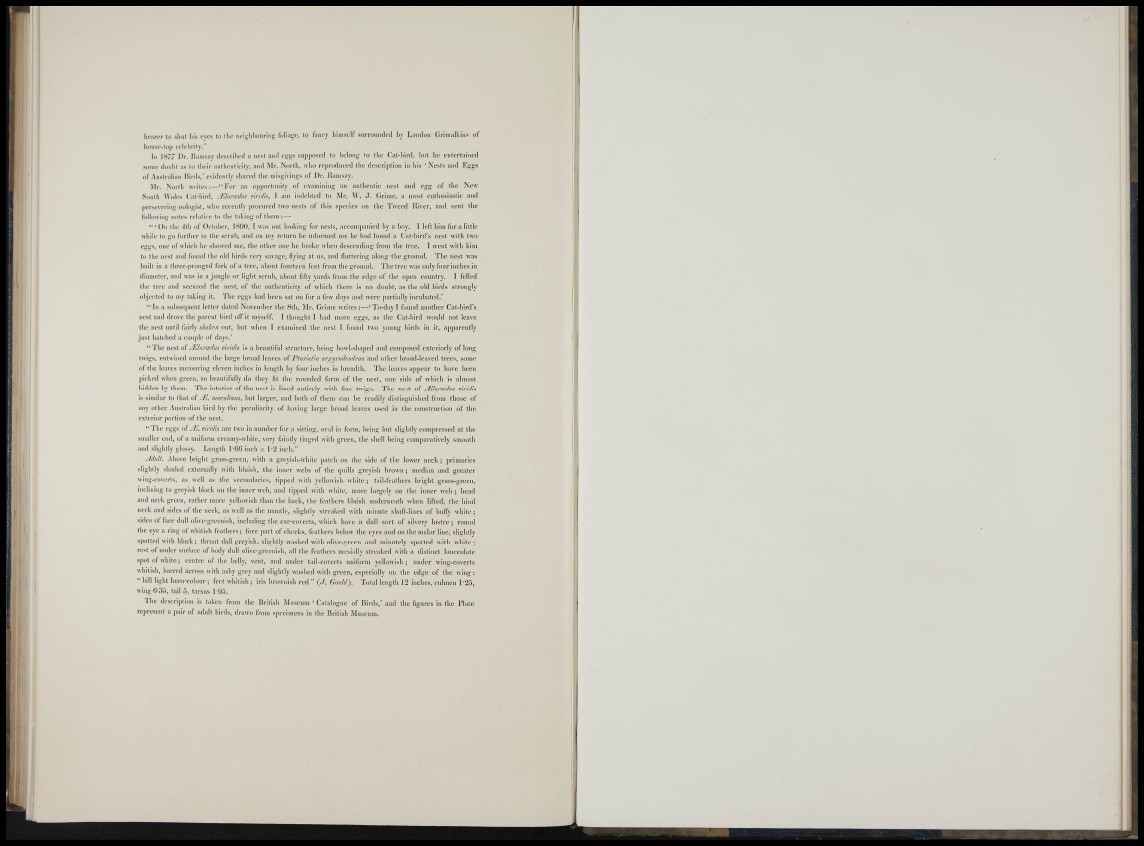
r r 1
liciii-cr lo sliiil Ills eves to llio iii'lglilioiiniig foliiigi', to faiic)" liiinself siirroiiiKlcd by London Grimalkins of
lionsc-l(i|i iTk'Inlfv."
Ill 1H77 l)i-. liiiinsay descrllu'd nest niiil eggs 5ii|i|)0scd to hcloiiij lo tlie Cat-[)ird, but he cntcrtainwl
some doiilit as lo llieir aiillienllclty, and Mr. Norlli, wlio reprodneed tlic dcserl]ition in liis ' Nests and Eggs
of Aiislrallaii liinis,' eviileiilly shared ihe misgivings of ])r. lianisay.
IMr. Norlh wriles:—"For an (ipportiniily of examining an aiilheiilie nest and egg of the New
Soiilh M ales ()at-l)ird, . El/irwi/iis piridis, I am indebted to Mr. AV. J . Grime, a most enthiisiustie and
|ierseierliig onlogist, who recently proenred two nests of this species on the Tweed liiver, and sent the
following notes relative to llie taking of them :—
" ' On the lib of ()ctol)er, 1890, I out looking for nests, accompanied hy a boy. I left liim for a little
while to go fiirllier In the seriib, and on iny return he informed me he had found a Cat-Iiird's nest with two
eggs, one of whieli he showed me, tiie oilier one he broke when descending from the tree. I went with him
to the nest and found the old birds very savage, flying at ns, and (Inttering along the ground. The nest was
built ill a lliree-pronged fork of a tree, about fourteen feet from the ground. The tree was only four inches in
diameter, and was in a jungle or light sernl), about fifty yards from the edge of the open country. I felled
llie tree and secured the nest, of the autheiiticitv of \vhieh there Is no donbt, as the old birds strongly
objected to my taking It. The eggs liad been sat on for a few days and were ])artially incubated.'
" III a subsequent letter dated November the ,Sth, Mr. Grime writes :—' To-day I found another Cat-bird's
nest and drove the parent bird olf it myself. I thought I had more eggs, as the Cat-bird would not leave
the nest until fairly s/iakcn out, but when I e.vamiiied the iiest I found two young birds in it, ap|)arently
just hatched a couple of days.'
" T h e nest of v'uidia is a beautiful structure, being bowl-shajied and composed exteriorly of longtwigs,
entwined around the large broad leaves o'i Ptanctia argyrodendroii ami other broad-leaved trees, some
of the leaves measuring eleven inches in length by four inches in breadth. The leaves appear to have been
picked when green, so beautifully do they lit the rounded form of the nest, one side of which is almost
hidden by tlicm. The interior of the nest is lined entirely with fine twigs. The nest of /Elaraidus niridis
is similar to that oiyE. mnculosus, but larger, and botli of them can be readily distinguished from those of
any other Australian bird hy the ])cenliarity of having large broad leaves used in the eonslruclion of the
exterior jiortion of the nest.
" T h e eggs (dVE tiriiHs are two in number for a sitting, oval In form, being but .slightly compressed at the
smaller end, of a uiiiforni ereamy-white, very faintly tinged with green, the shell being comparatively smooth
and slightly glossy. Length I'GO Inch x inch."
Adult. Above bright grass-green, with a greylsh-wlilte patch on the side of the lower neck ; primaries
slightly shaded externally with bluish, the inner webs of the tjiiills greyish brown ; median and greater
wing-eoverts, as well as the secondaries, tipped with yellowish white ; tail-feathers briglit grass-green,
iiiclliiliig to greyish black on the inner weh, and tipped with white, more largely on the inner web ; head
and neek green, rather more yellowish than ihe back, ihe feathers bluish underneath when lifted, the hind
neck and sides of the neck, as well as the mantle, slightly streaked with minute shaft-lines of buify white ;
sides of faee dull olive-greenish, ineludiiig the ear-coverts, which have a dull sort of silvery lustre; round
the eye a ring of whitish feathers ; fore part of cheeks, feathers below the eyes and on the malar line, slightly
spotted with blaek ; throat dull greyish, slightly washed with olive-green and minutely spotted with white ;
rest of under surface of body dull olive-greenish, all the feathers incsially streaked with a distinct lanceolate
sjiot ot white; centre of the belly, vent, and under tail-coverts uniform yellowish; under wing-eoverts
whitish, barred across with ashy grey and slightly washed with green, especially on the edge of the wing:
" bill light horn-colour ; feet whitish ; iris brownish red " (./. Gould). Total length 12 inches, culmen 1-25,
wing()-;j.5, tail o, tarsus 1-95.
The description is taken from the British Museum ' Calalogue of liirds,' and the figures in the Plate
rej)resent a pair of adult birds, drawn from specimens in Ihe British Museum.